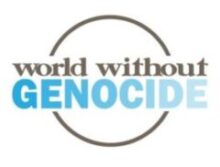Genocide is an Iceberg
Ellen J. Kennedy, Ph.D.
Executive Director
The Titanic sank when it hit an iceberg. An iceberg’s appearance is deceptive. Only a small part is above the water line but it goes far under the ocean, invisible and deadly to an extent that people on the surface don’t anticipate.
What is the relationship between an iceberg and genocide?
On the surface, we think that genocide is caused by the factors in the UN Genocide Convention: “the intent to exterminate, in whole or in part, a national, ethnic, racial, or religious group.” Genocides have been labeled with these characteristics: Armenian Christians persecuted in the Muslim Ottoman Empire; Jews exterminated by Aryan Nazis; Tutsis in Rwanda persecuted by Hutu neighbors; Muslims slaughtered by Serbs in Srebrenica; Yazidis in Syria killed by Muslims; Uighurs in China targeted by the Han; etc.
We tend to believe that people kill others because of competing backgrounds and beliefs.
But there are many places in the world where people see the world differently, have different backgrounds and experiences, and yet live together in harmony.
So why does genocide happen in some places and not in others?
Those defining characteristics are only the visible tip of the iceberg. Skin color. Ethnicity and national origin, discernable through language. Religion, labeled by clothing or other outward signs.
It’s easy to see the manifestations on the tip of the iceberg and to categorize people accordingly. And when we can categorize them, we single them out as being different, as “other” from us.
But these characteristics, by themselves, don’t create hate, fear, or polarization, and they don’t lead to genocide.
What’s below the tip of the iceberg does that.
The potentially deadly factors are under the iceberg’s tip: political instability and economic turmoil. These are the ultimate causes of genocide. They motivate a weak ruling elite to rally a majority population that is desperately fearful about an uncertain future. The leaders blame a vulnerable racial, religious, ethnic, or national minority for everything unfortunate that is happening and encourage the majority to target the minority. Politics and economics drive hatred and violence.
If we go further yet below the iceberg’s surface, we find a ‘force multiplier’ and a trigger, a factor that makes a country’s internal turmoil even worse: climate change. Famines from floods, droughts, and other natural disasters can push an already-shaky government to take desperate measures.
Climate experts document conditions that indicate a likelihood of violence connected with extremes in temperatures and rainfall:
- communities that are vulnerable to adverse climatic conditions,
- communities where institutions can’t respond effectively to agricultural devastation and the flight of hungry rural people to the cities, and
- communities where people at risk can’t obtain essential services.
We must look below the surface to prevent violence. We must be watchful of hate-filled messages that take root during political and economic upheaval. We must strengthen civil society in vulnerable communities, promote practices in rural areas to withstand the ravages of drought and flood, and, ultimately, we must address climate change, the hidden ‘force multiplier’ of violence.




Leave a Comment